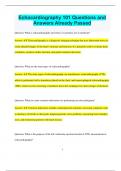Echocardiography 101 Questions and
Answers Already Passed
Question: What is echocardiography and what is its primary use in medicine?
Answer: ✔✔ Echocardiography is a diagnostic imaging technique that uses ultrasound waves to
create detailed images of the heart's structure and function. It is primarily used to evaluate heart
conditions, monitor cardiac function, and guide treatment decisions.
Question: What are the main types of echocardiography?
Answer: ✔✔ The main types of echocardiography are transthoracic echocardiography (TTE),
which is performed with a transducer placed on the chest, and transesophageal echocardiography
(TEE), which involves inserting a transducer down the esophagus for closer images of the heart.
Question: What are some common indications for performing an echocardiogram?
Answer: ✔✔ Common indications include evaluating heart murmurs, assessing symptoms such
as shortness of breath or chest pain, diagnosing heart valve problems, measuring heart chamber
sizes, and monitoring patients with heart disease.
Question: What is the purpose of the left ventricular ejection fraction (LVEF) measurement in
echocardiography?
1
,Answer: ✔✔ The left ventricular ejection fraction (LVEF) measurement assesses the percentage
of blood pumped out of the left ventricle with each heartbeat. It helps evaluate the heart's
pumping efficiency and is crucial for diagnosing heart failure and monitoring cardiac function.
Question: What is Doppler echocardiography and how is it used?
Answer: ✔✔ Doppler echocardiography measures the speed and direction of blood flow within
the heart and its valves by analyzing the change in frequency of the ultrasound waves reflected
by moving blood cells. It is used to assess blood flow patterns and detect issues like valve
stenosis or regurgitation.
Question: What are some potential complications of echocardiography?
Answer: ✔✔ Echocardiography is generally safe with minimal risks. Potential complications are
rare but can include discomfort from the transducer, esophageal irritation with TEE, and in very
rare cases, allergic reactions to contrast agents used in some procedures.
Question: How does echocardiography assist in the management of heart valve diseases?
Answer: ✔✔ Echocardiography helps in diagnosing and assessing the severity of heart valve
diseases by visualizing valve structure and function, measuring valve opening and closing, and
evaluating the impact of valve abnormalities on heart chambers and blood flow.
2
,Question: What role does echocardiography play in preoperative and postoperative cardiac care?
Answer: ✔✔ In preoperative care, echocardiography helps evaluate cardiac function and
structure before surgery, identifying potential risks. Postoperatively, it monitors the heart's
recovery, assesses the effectiveness of interventions, and detects complications early.
Question: What is the significance of measuring heart chamber sizes in echocardiography?
Answer: ✔✔ Measuring heart chamber sizes helps assess the heart's ability to pump blood
effectively and identify conditions such as cardiomyopathy or heart enlargement. It provides
important information for diagnosing and managing various cardiac disorders.
Question: How is echocardiography used to evaluate congenital heart defects?
Answer: ✔✔ Echocardiography is used to visualize and diagnose congenital heart defects by
providing detailed images of the heart's structure, including abnormal connections, shunts, and
malformed valves. It is essential for planning surgical or interventional treatments.
Question: What are the differences between 2D and 3D echocardiography?
Answer: ✔✔ 2D echocardiography provides flat, two-dimensional images of the heart, while 3D
echocardiography offers three-dimensional views, allowing for more comprehensive assessment
of cardiac anatomy and function, which can be particularly useful for complex cases.
3
, Question: Why might contrast agents be used in echocardiography?
Answer: ✔✔ Contrast agents enhance the visibility of cardiac structures and blood flow during
echocardiography, improving image quality and clarity, especially in patients with poor image
quality due to factors such as obesity or lung disease.
Blood flow ✔✔Svc, Ivc, Cs, - RA - TV - RV - PV - MPA - RT & LT PA - arterioles -
pulmonary capillaries - venules - PV4 - LA - MV - LV - AOV - AAO - aortic arch - descending
thoracic aorta - descending abdominal aorta - rt & lt common iliac artery - arteries - arterioles -
capillaries - venules - veins - SVC, IVC, CS - RA
The left heart is associated with the _______ circulatory system ✔✔Systemic
high pressure, high resistance, O2 sat 98%
The right heart is associated with the ________ circulatory system. ✔✔Pulmonary
low resistance, low pressure, O2 sat: 75%
Pulmonic Valve Cusps ✔✔Anterior, Right Posterior, and Left Posterior
Are the semilunar valves open or closed during systole? ✔✔Open
4




